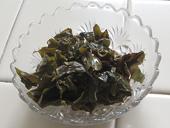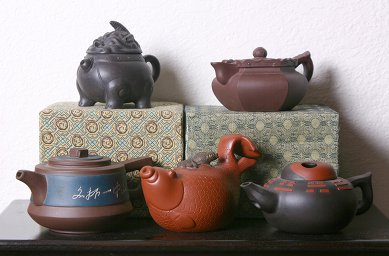Multiple Infusions
Last Updated: Aug. 28, 2018
Multiple infusions of tea
Tea leaves can be brewed more than once, and the steeping of tea leaves multiple times is usually referred to by the term multiple infusions. Westerners also sometimes use the terms rebrewing or resteeping. Multiple infusions are the norm for traditional Chinese and Japanese brewing of green teas, oolong teas, and Pu-erh tea, and to some degree white tea. Less frequently, they can also be used for preparing black or herbal teas.The making of multiple infusions can be a way to save money and promote sustainability by getting more mileage out of the same amount of tea leaf. This technique is also a favorite approach of tea connoisseurs, as each steeping can bring out subtle differences between each cup that can add a new level of complexity to the appreciation of a tea. The same considerations of water quality, amount of leaf used, temperature, water temperature, and steeping time also apply when making more than one infusion. The basics of these variables are discussed on our page on brewing tea.
Which teas work best for multiple infusions?

Whole-leaf teas like this oolong
work well for multiple infusions
Finely-broken teas, especially fannings and CTC(crush-tear-curl) tea (see grades of tea for explanation of these terms), tend to infuse very quickly, and are rarely good for multiple infusions. For this same reason, herbal teas with a delicate leaf or small particle size, such as rooibos and honeybush, tend not to be as good for multiple infusions. Usually, fewer black teas are good for multiple infusions, as the oxidation process reduces the leaf size and results in a leaf that infuses faster, although whole-leaf black teas are usually able to be resteeped at least once.
Traditionally-scented teas such as jasmine tea, which have been scented by repeated mixing of the tea leaf with fresh flowers, tend to hold their aroma through multiple infusions better than teas that have been artificially flavored or infused in one step with the extract or oil of a plant.
These general trends all have exceptions; some individual teas work better with multiple infusions than others for a variety of reasons. Yerba maté can often be brewed multiple times, even when it is finely broken.
Multiple infusions with tea bags
Although enthusiasts of loose tea are usually the ones who talk most about multiple infusions, the same practice is often quietly carried out by frugal drinkers of tea bags. Tea bags inhibit the diffusion of water, which in this case actually facilitate the practice of resteeping. Although most tea bags are filled with broken-leaf tea, fannings, or dust, which normally infuses quickly, the fact that the leaf is tightly constrained within the teabag makes the tea infuse more slowly. Because of this, multiple infusions can sometimes work well with tea bags, even those containing finely-broken leaves.Gongfu brewing
Gongfu brewing is a method of brewing loose tea that originated in China and is part of the Chinese gongfu tea ceremony. The term gongfu(功夫), also spelled kung fu, means skill, art, labor, or effort; it is the same word as the martial art Kung Fu, and it has a stronger and deeper connotation than the English words skill or effort. This naming reflects the fact that gongfu brewing is quite involved and requires a great deal of practice and experience to learn how to carry out effectively.Gongfu is typically used for oolong and pu-erh tea, and sometimes green tea, but any tea or herbal tea can be brewed in this manner. A small clay teapot is used; commonly a Yixing(宜兴) teapot is used for this purpose; these pots are named after a city in Jiangsu province, although other types of clay teapots may be used. The teapot is much smaller than most western teapots, the amount of tea leaf used in gongfu brewing is typically much greater than that typically used in western brewing or the amount used to brew a single cup of tea, and the infusion times are much shorter. The first infusion is typically discarded, which is sometimes referred to as "washing" the tea.
Gongfu brewing has the advantage of bringing out nuances of aroma and flavor with each subsequent steeping that are not distinguished when brewing with longer infusions. Chemically speaking, this happens because different aroma and flavor chemicals diffuse at different rates. Sometimes people refer to "gongfu-style brewing" to mean the brewing of tea using large quantities of leaf and short brewing times, even if they are not using the traditional teacups and clay teapot of proper gongfu brewing.
Gongfu brewing requires experimentation to master. The optimal temperature, quantity of leaf, and steeping times vary not only by the individual tea but also by the teapot used, and the tastes and preferences of the people drinking the tea.


